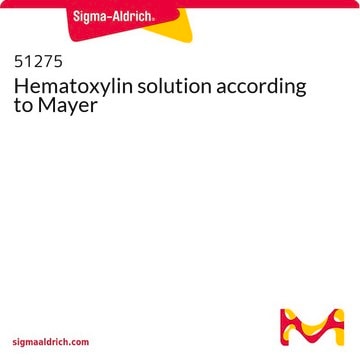Transportation information can be found in Section 14 of the product's (M)SDS.To access the shipping information for this material, use the link on the product detail page for the product.
MHS128
Mayer′s Hematoxylin Solution
Synonyme(s) :
(6aS,11bR)-7,11b-Dihydroindeno[2,1-c]chromene-3,4,6a,9,10(6H)-pentol, Delafield′s hematoxylin, Progressive stains
Sélectionner une taille de conditionnement
Sélectionner une taille de conditionnement
About This Item
Produits recommandés
Forme
solution
Durée de conservation
Expiry date on the label.
IVD
for in vitro diagnostic use
Concentration
1 g/L
pH
2.4 (25 °C)
Application(s)
hematology
histology
Température de stockage
room temp
Chaîne SMILES
Oc1cc2C[C@@]3(O)COc4c(O)c(O)ccc4[C@H]3c2cc1O
InChI
1S/C16H14O6/c17-10-2-1-8-13-9-4-12(19)11(18)3-7(9)5-16(13,21)6-22-15(8)14(10)20/h1-4,13,17-21H,5-6H2/t13-,16+/m0/s1
Clé InChI
WZUVPPKBWHMQCE-XJKSGUPXSA-N
Vous recherchez des produits similaires ? Visite Guide de comparaison des produits
Catégories apparentées
Description générale
Application
Autres remarques
Code de la classe de stockage
12 - Non Combustible Liquids
Classe de danger pour l'eau (WGK)
WGK 2
Point d'éclair (°F)
Not applicable
Point d'éclair (°C)
Not applicable
Faites votre choix parmi les versions les plus récentes :
Déjà en possession de ce produit ?
Retrouvez la documentation relative aux produits que vous avez récemment achetés dans la Bibliothèque de documents.
Les clients ont également consulté
-
What is the Department of Transportation shipping information for this product?
1 réponse-
Utile ?
-
-
There are several Mayer's Hematoxylins listed on the website, beginning with the letters MHS. What are the differences?
1 réponse-
Products MHS1, MHS16, MHS32, MHS80 and MHS128 are in fact the same product. In this case a unique product number was assigned to each package size. Other than the package size, there are no differences in formulation or use.
Utile ?
-
-
There is also a product listed on the website as Hematoxylin Solution According to Mayer. What is the difference between product 51275 and the various Mayer's Hematoxylin solutions?
1 réponse-
The basic formulations are the same. Both include chloral hydrate, although some of the concentrations could vary slightly. Product 51275 is not intended for In Vitro Diagnostic Use. Product 51275 is not CE Marked. The various Mayer's Hematoyxlin solutions are intended For In Vitro Diagnostic Use and are also CE Marked. Product inserts are available for various languages.
Utile ?
-
-
The slides were stained with Mayer's Hematoxylin but the nuclei are not blue. Why?
1 réponse-
The nuclei will originally appear as the same color as the solution. Only after the slides have been "blued" will the nuclei appear blue. The pH of the solution is acidic. This acidic pH promotes specific staining. However the slides must be washed in an neutral or alkaline solution for the color to shift to blue. Prolonged warm water washes in tap water are often sufficient for the bluing to occur. To shorten the time spent in washing, various bluing agents are often used to shorten the blueing process. Scott's Tap Water Substitute (Product No. S5134) is one such blueing agent.
Utile ?
-
-
The website states that Mayer's Hematoxylin solution is a progressive type hematoxylin. What is a progressive type hematoxylin?
1 réponse-
Hematoxylin solutions are generally classified as either progressive or regressive. Progressive formulations will stain only the nucleus. No staining should occur within the cytoplasm. Regressive hematoxylins have higher dye contents and if used for sufficient periods of time will overstain both the nucleus and the cytoplasm. Acid differentiation is required to remove the excessive stain from the cytoplasm and nucleus. This differentiation take practice to master. Too much or too little stain can be removed during differentiation, resulting in poorly stained slides. For users lacking extensive experience with the Hematoxylin and Eosin staining procedure, progressive hematoxylin formulations are often the better choice.
Utile ?
-
-
Is chloral hydrate used in the preparation of Mayer's Hematoxylin? Does this mean the solution is controlled as a DEA Schedule IV product?
1 réponse-
Yes, chloral hydrate is included in the formulation. No, the solution is not controlled as a DEA Schedule IV product. Once the choral hydrate is mixed with the remaining chemicals, it is impossible to obtain the chloral hydrate in a purified form.
Utile ?
-
Filtres actifs
Notre équipe de scientifiques dispose d'une expérience dans tous les secteurs de la recherche, notamment en sciences de la vie, science des matériaux, synthèse chimique, chromatographie, analyse et dans de nombreux autres domaines..
Contacter notre Service technique







